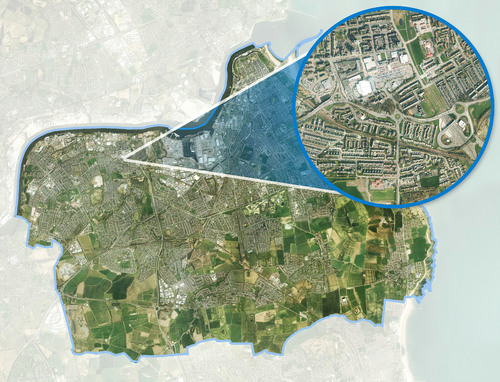South Tyneside Council takes to the air to police planning permissions with Bluesky aerial photomaps
Leicestershire, 15 June 2016 – South Tyneside Council is using the latest aerial survey data from Bluesky to update essential Council records and inform decision making. By comparing the new photography with previous imagery, officers are even able to identify potential breaches of planning permission and land encroachment.
Flown in 2015 and delivered to the Council in early 2016, the Bluesky high resolution aerial photography is being deployed to specialist users in Planning and Highways, for example, within the Council’s desktop Geographical Information System (GIS) and, using standard web browser technology, across the organisation via the Council’s intranet. Plans are also in place to update the Council’s community website, giving residents and businesses in the area access to the Bluesky imagery.
South Tyneside Council is a long term user of aerial photography, and has worked with Bluesky for many years to ensure officers within the Council have access to the most up to date, high quality and accurate images available. “Unfortunately, due to budget restraints, we had not been able to update our aerial photography for several years,” commented Andrew Tracey, Performance and Information Officer at South Tyneside Council. “So when funds became available in 2015, we were very keen to see what was on offer. We reviewed a number of options, but concluded the Bluesky 2015 survey was the most up to date and cost effective solution.”
The Bluesky data is already being used across a number of strategic departments, including Planning, Highways and Asset Management. Users within Planning compare different ages of Bluesky imagery to identify suspected breaches of planning control, including developments that do not have the required planning permission as well as those that have failed to comply with conditions or limitations of granted permission. The Bluesky imagery can also be used as evidence when considering possible enforcement action.
The different ages of Bluesky imagery also help the Council identify and resolve boundary disputes where residents or businesses may have encroached on Council land, while other applications of the Bluesky data include use by Officers to identify and record features not referenced on traditional map layers, such as street furniture, road markings, street lights, trees and other Council assets.
“The Bluesky imagery is easy to use and easy to interpret, making it a valuable resource for users across the organisation,” continued Andrew Tracey. “By comparing different ages of imagery, Officers can easily identify changes – permitted or not – and take the necessary action based on the evidence before them. They can also identify ground features not available from other sources due to the currency and quality of the photography. This helps improve the efficiency and quality of decision making and helps decrease costs by reducing the need for site visits.”
CONTACTS:
Bluesky:
Laura Eddy, tel +44 (0)1530 518 518, laura.eddy@bluesky-world.com, www.bluesky-world.com
Editorial and Advertising:
Robert Peel, tel +44 (0)1666 823306, robert@market-it.co.uk
This press release was distributed by ResponseSource Press Release Wire on behalf of The Marketing Edge in the following categories: Environment & Nature, Public Sector, Third Sector & Legal, Construction & Property, for more information visit https://pressreleasewire.responsesource.com/about.
